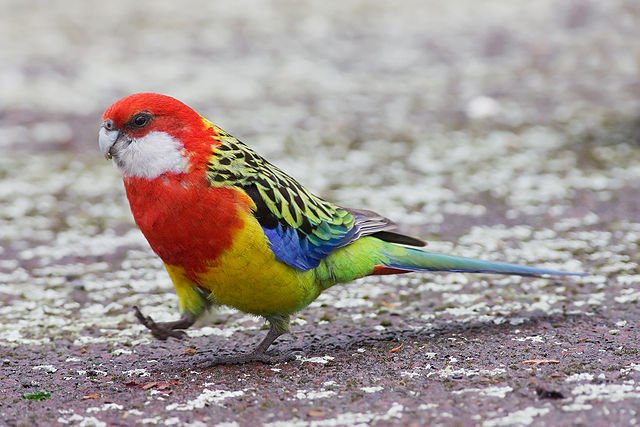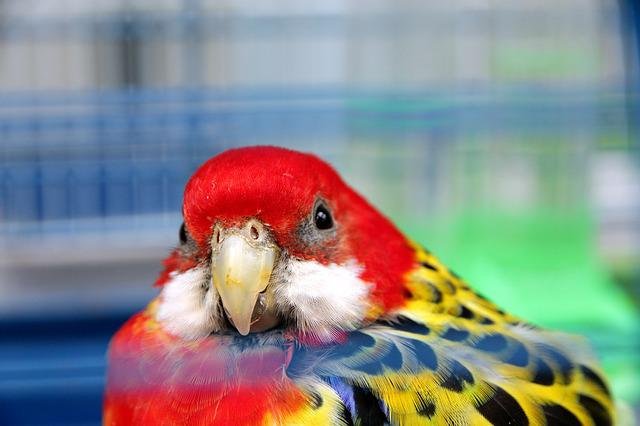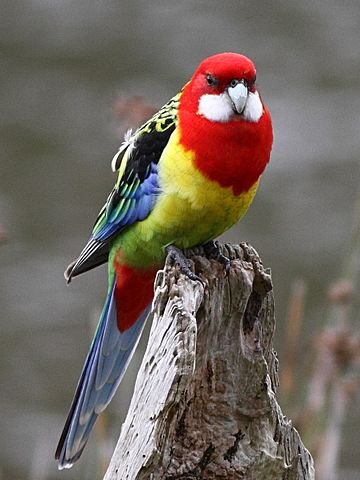Spotting colorful parrots in Australia is extremely common. And why shouldn’t it be? The continent is home to numerous parrot species. If one spots a small-sized parrot with almost a single color plumage, chances are high that it might be a budgerigar.
But if the parrot is vividly colored along with being small, that might be a rainbow lorikeet. Then comes the medium-sized most common parrots in Australia; Rosellas. The word itself covers many classes of species. But the one that can be easily spotted is Common Rosellas aka Eastern Rosella.
Common Rosellas are called so as they are everywhere. Ranging from northern to southern regions and covering Tasmanian regions, one can practically spot this species or its subspecies almost anywhere they go. But how can the species be distinguished from other innumerable parrot species of Australia?
Forget about the rest of the species, how Eastern Rosellas differ from the remaining six Rosella species like Crimson Rosellas, Western Rosellas, Northern Rosellas, et al. Let’s understand the Eastern Rosellas colors and their mutations thereof to identify them in the wilderness.
Eastern Rosella Colors
The most distinct feature of Eastern Rosellas is the white cheek patch that distinguishes them from a few other blue cheeked Rosella species like Yellow Rosella, Adelaide Rosella, Tasmanian Rosella, et al. The species Eastern Rosella further covers three subspecies including the nominate subspecies, i.e., Eastern Rosella itself. All three of them vary in colors and markings and hence can be distinguished easily.

Eastern Rosella
Scientifically known as Platycercus Eximius Eximius, this subspecies is the most common Easterns across the globe. They can be found throughout the southern region of New South Wales along with Victoria. The species has a red-head and upper breast. The lower breast is yellow that turns into greenish-yellow as it goes down to the abdomen. The cheeks patches and the beak are white. The nape and back are black with greenish-yellow edges. And the rump is bright green.

Talking about the tail and the wings, it has elaborate colors with under-tail coverts being red like his head. The outer-wing coverts and the bend of the wing both are blue. The underside of the tail is blue. The eye-rings can be grey to dark grey. The irises are a darker shade of brown. The feet of the Easterns are also grey.
The female Easterns are also similar in basic color patterns and markings. But some noticeable differences can make an expert identify the gender of the birds apart. The foremost difference is the color of the plumage in females that happens to be a duller shade of red. The bills of the females are also narrower. The other colors of the plumage like green and blue are also less bright than that of their counterparts. Additionally, the females have a white under-wing stripe.
And for the juveniles, the plumage color is even duller than females. Also, the crown and the nape area is green instead. The under-wing stripe can also be seen, a little paler than the females though.
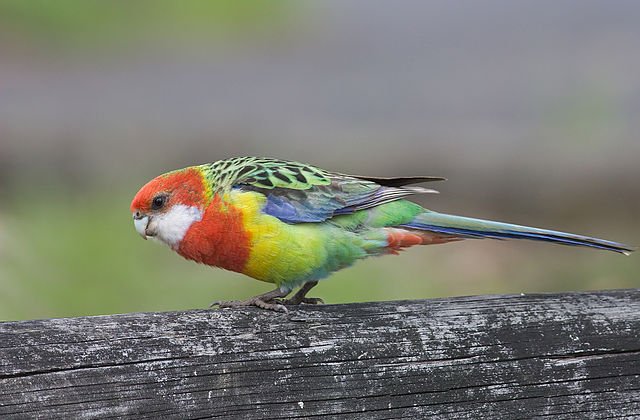
Golden Mantled Rosella
Scientifically known as Platycercus Eximius Cecilae, the subspecies inhabits the northeastern region of New South Wales and southeastern one of Queensland. There aren’t many differences in the color of the plumage. The only distinct marking that is enough to tell them apart is the golden-yellow edges of the black back feathers against the greenish-yellow edges in the subspecies; Eastern Rosella. These bright-golden hued edges can be seen on the feathers of the mantle and the wings too.
Another distinction is the blue hue on the rump and the vent instead of the green as in the other subspecies. Both the genders have not many differences besides the basic ones like smaller bills in females and an overall duller plumage.
Tasmanian Eastern Rosella
Scientifically known as Platycercus Eximius Diemenensis, the subspecies is called the ‘Tasmanian Eastern Rosella’ as it is widespread throughout the eastern Tasmanian region. Though their spotting in that region is enough to identify them, there are still a few major differences that make the subspecies distinguishable from afar.
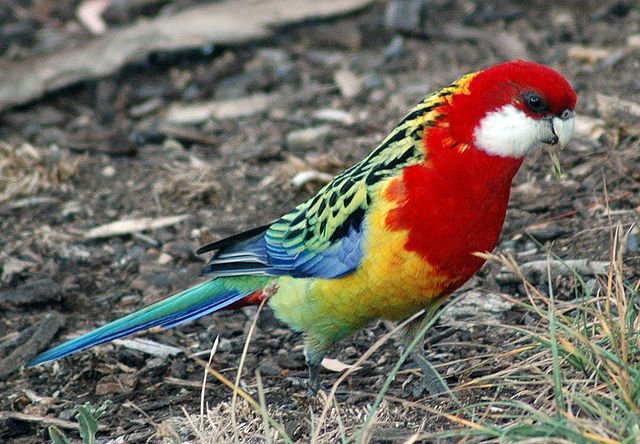
The foremost difference is the larger and cleaner white patches on the cheek. Also, the plumage color on the head is of a noticeably darker shade. The subspecies has a brighter and a bigger Easterns than the abovementioned subspecies. Additionally, one will rarely find these subspecies in the inner dense forests as these birds have a liking for the open and not-so-dense forest regions.
Hybrid of Eastern Rosella
A few hybrids of the Easterns have been recorded in the wild and in captivity too. The resultant offsprings are an obvious mix of both the parent’s features, colors, and markings. Some recorded hybrids of Easterns are:
Red Mantled Rosella
This hybrid is a result of the interbreeding of Eastern Rosella with the Crimson Rosella. The plumage of the hybrid birds is much like Crimson, i.e, a red rump, red and black mantle feathers, and a deep blue tail. From the Easterns, the offspring attains yellow edges of the back feathers and a pale green upper tail coverts. The abdomen is also pale blue instead of the usual pale green or yellow. The cheek patches are the most distinct feature being sky blue, unlike, white in Easterns and blue in Crimsons.
Eastern Rosella X Pale-Headed Rosella
Hybrid between Eastern and Pale-headed rosellas have been spotted in the region where both of their habitat ranges meet, i.e., in southeastern regions of Queensland and northeastern region of New South Wales. Not much has been documented about their hybrid apart from a mention of a few sightings in the specified region.
Eastern Rosella Color Mutations
Color mutations are common in almost all the species of parrot kingdom and Easterns are no exception. There have been numerous successful attempts by the breeders towards making Eastern’s color mutations. But following are the few that are commonly bred and seen:
Black Eastern Rosella
This color mutation is a result of recessive mutation technique. The result is a complete black bird with red-head and white cheek patches. The mutation is quite easy to sex and hence is more popular.
Red Eastern Rosella
Another popular color mutation is the Red Eastern that is a result of sex-linked mutation. They are also referred to as Opaline Eastern Rosella. The whole plumage of the bird is a rich shade of blood-red with the usual white cheek patches. The offspring are believed to lack longevity, especially in the wild.
Lutino Eastern Rosella
A Lutino Eastern color mutation is being bred with two different techniques namely, recessive and sex-linked. In both the techniques, the offspring has only yellow and red colors with the absence of the remaining green, blue, and black markings. Also, the eyes are red.
Pastel Eastern Rosella
Also known as the Dilute Eastern Rosella color mutation, the bird is all grey, yellowish-green and light blue. The mutation is achieved with recessive technique of mutation.
Pied Eastern Rosella
A rare breeding attempt, Pied Rosella are a result of the Dominant color mutation technique. Not much has been reported about the resultant bird apart from the fact that they are in scanty numbers, even in Australia.
Cinnamon Eastern Rosella
As a result of the sex-linked color mutation technique, Cinnamon Easterns have brown color replacing all the black in the original bird. The green and blue shades are also much lighter than otherwise.
Other Color Mutations of Eastern Rosella
Apart from the above-mentioned popular Eastern’s color mutations, breeders have always been experimenting to breed a new and fascinating mutation of Eastern. A few attempts have given birth to colors like Creme-Ino Opaline, Dilute opaline Cinnamon, White-Winged Cinnamon, White-Winged Opaline, Cinnamon, Black, Lutino Black, Par-Blue, Par-Blue Ino, Opaline Ino/Rubino, Opaline Cinnamon, Dilute Cinnamon, Dilute Opaline, Golden, et al.
All these color mutations have been successfully bred. But they haven’t gained much fame because of their high price and non-availability.
Summing Up
Easterns Rosellasor or as they are more commonly known as; Common Rosella, are a loved bird, especially in the Australian continent. The bird is petted as well as pampered by many in their backyards. And their mesmerizing colors have played a major role in gaining all the love and attention from one and all.
Initially not petted so widely, the vivid colors of the bird caught the fancy of bird lovers and breeders alike. And from the wild, they made way to many homes. Those who are simply happy to look at their attractive colors and still content, choose a different way of introducing their colors in their lives. Grow some of their favorite plants and shrubs in the backyard and see a few of them getting attracted to all the nectar and seeds. This is the easiest way to have these colorful birds around without having constant responsibility to take care of them. And what better than the Easterns also are content getting your companionship along with the chance to stay with their colorful flock.
Read more about Eastern Rosella Diet:
https://parrotquaker.com/eastern-rosella-diet/
Read about behavior:
https://parrotquaker.com/eastern-rosella-behavior/

